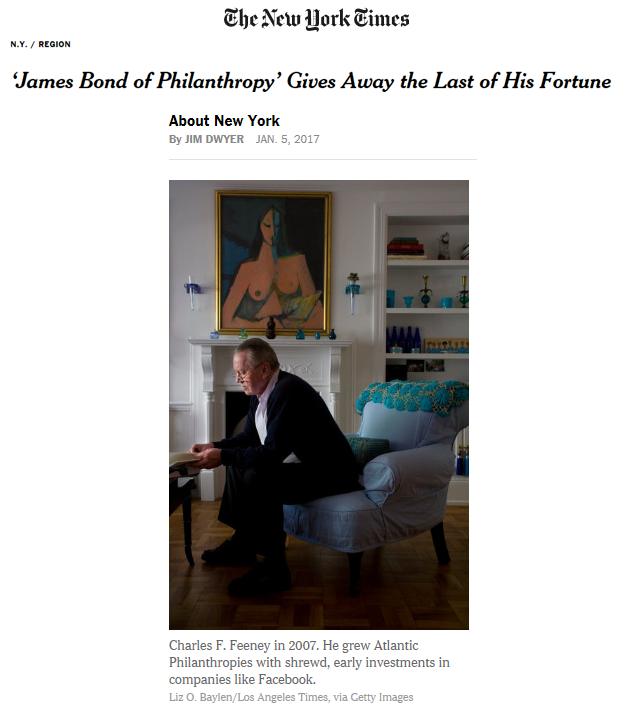What a great icon & example
As it happens, Donald J. Trump is not the only person to announce plans to shut down a personal philanthropy, just the best known.
This is the story of a man who made and kept that same promise.
Nearly five years ago, Charles F. Feeney sat in a cushy armchair in an apartment on the east side of Manhattan, grandchildren’s artwork taped to the walls, and said that by the end of 2016, he was going to hand out the last of a great fortune that he had made.
It was a race: Mr. Feeney was then 81, and Atlantic Philanthropies, a collection of private foundations he had started and funded, still had about $1.5 billion left. Flinging money out the window or writing checks willy-nilly was not Mr. Feeney’s way.
Last month, Mr. Feeney and Atlantic completed the sprint and made a final grant, $7 million to Cornell University, to support students doing community service work.
He had officially emptied his pockets, meeting his aspiration of “giving while living.” Altogether, he had contributed $8 billion to his philanthropies, which have supported higher education, public health, human rights and scientific research.
“You’re always nervous handling so much money, but we seem to have worked it pretty well,” Mr. Feeney, now 85, said last week in a phone interview.
His remaining personal net worth is slightly more than $2 million. That’s not quite broke, by any standard, but it is a modest amount for a man who controlled thousands of times as much wealth. He and his wife, Helga, now live in a rented apartment in San Francisco.
“You can only wear one pair of pants at a time,” Mr. Feeney has said.
Until he was 75, he traveled only in coach, and carried reading materials in a plastic bag. For many years, when in New York, he had lunch not at the city’s luxury restaurants, but in the homey confines of Tommy Makem’s Irish Pavilion on East 57th Street, where he ate the burgers.
None of the major American philanthropists have given away a greater proportion of their wealth, and starting in 1982, Mr. Feeney did most of this in complete secrecy, leading Forbes magazine to call him the “James Bond of philanthropy.”
His name does not appear in gilded letters, chiseled marble or other forms of writing anywhere on the 1,000 buildings across five continents that $2.7 billion of his money paid for. For years, Atlantic’s support came with a requirement that the beneficiaries not publicize its involvement.
Beyond Mr. Feeney’s reticence about blowing his own horn, “it was also a way to leverage more donations — some other individual might contribute to get the naming rights,” said Christopher G. Oechsli, the president and chief executive officer of Atlantic.
During the early 1990s, Mr. Feeney met secretly with paramilitary forces in Belfast, Northern Ireland, urging them to drop armed guerrilla conflict and promising financial support if they embraced electoral politics. Atlantic grants paid to create a public health system in Vietnam, and to provide access to antiretroviral treatment for AIDS in southern Africa. The last rounds of grants, about $600 million, included support for Atlantic Fellows, described as young emerging leaders working in their countries for healthier, more equitable societies.
Raised in Elizabeth, N.J., Mr. Feeney served as a radio operator in the Air Force and attended Cornell University on the G.I. Bill. In 1960, he and a partner set up a company that sold items like brandy and cigars to travelers in duty-free shops at airports. It became a booming success. Mr. Feeney has also been a shrewd investor in technology start-ups.
In 1984, he secretly transferred all of his assets, including his 38.75 percent ownership of the duty-free business, to Atlantic Philanthropies. He grew the Atlantic pot with early investments in companies like Facebook, Priceline, E-Trade, Alibaba and Legent.
A business dispute in 1997 forced disclosure of Mr. Feeney’s funding for Atlantic.
As for Mr. Trump, if he really does shut down his foundation — stung by inquiries about the use of foundation money to pay Mr. Trump’s personal liabilities, or purchase football helmet memorabilia, or oil paintings of himself — he is not likely to follow the Feeney model.
The two men are mirror images. For years, Mr. Trump lobbied hard to get onto lists of the wealthy, like the Forbes 400; Mr. Feeney has tried to stay off them. The Atlantic endowment came entirely from Mr. Feeney’s money; much of the money that went into the Trump foundation in recent years was from others.
One of Atlantic’s projects was to propose reforms to the American health care system, which helped lay groundwork for the Affordable Care Act; another was advocacy for the end of the death penalty for juveniles. Mr. Trump has been on the other side of both of those issues, vowing to “dismantle Obamacare on Day 1,” and calling, in 1989, for the restoration of the death penalty after five teenagers were arrested in the rape of a jogger in Central Park. (They were convicted but later cleared of the charges.)
Just as Mr. Trump was opening Trump Tower on Fifth Avenue in the early 1980s, Mr. Feeney was a few blocks away in Makem’s pub, thinking about the first big checks he would write for charity, on the condition that his identity not be disclosed. “I don’t recall ever meeting Trump,” Mr. Feeney said last week.
No wonder. The thought crossed my mind 20 years ago that Chuck Feeney is what Donald Trump would be, if he lived his entire existence backward.
related posts
-
Michelle Obama Speech
This personal and authentic speech by Michelle Obama shook me to the core. All Trump supporters have a responsibility to listen to it with an open mind. It is just the last of many datapoints that cannot be ignored.














Comments are closed.